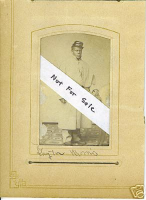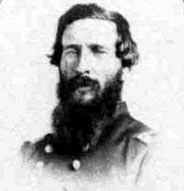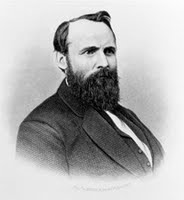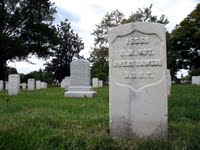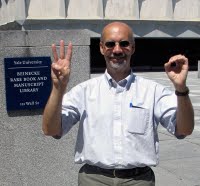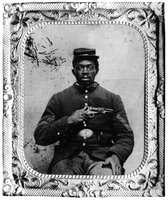An Account of the Death of Isaiah Owens
The complete transcription of the original five-page handwritten document copied at the National Archives is included here. Although the length of this document is unusual (one to two pages is average), it shares much in common with similar legal documents of record in pension files. The use of "that," "said," and other terms is normal. Also of note is the structure: The opening always includes the introduction of the clerk and the witnesses, and ends with a statement or statements that none of the individuals appearing have any interest in the case.
The transcription has several valuable details about Isaiah Owens — if you have the focus and patience to read each and every word!
State of Missouri
County of Marion
On this 30th day of December A.D. 1868 before me, John V. Gibbon Clerk of the Hannibal Court of Common Pleas, being a Court of Record in said County & State, personally appeared Henry Combs and Zachariah Johnson residents of Hannibal in said County, whom I certify to be respectable & credible witnesses, who being by me first duly sworn, depose & state:
That they reside as stated, that they were both formerly Privates in Company “C” Capt. Eli Ramsay in the 60th Regt. of U.S. Colored Troops during the late rebellion, & that they enlisted therein in August A.D. 1863.
That they were acquainted with Isaiah Owens in his lifetime, who enlisted in the same Co. & Regt with them in September 1863. That they were both acquainted with said Isaiah Owens prior to his enlistment in said Co, said Zachariah Johnson for over four (4) years before, and said Henry Combs for over two (2) years before; that they both lived during the said time of their acquaintance with said Isaiah Owens before his enlistment as aforesaid, in the same neighborhood with said Isaiah Owens, & were quite intimate with him, and that during all the said time of their acquaintance with him before his said enlistment, said Isaiah Owens was to the knowledge of each of these deponents, a strong, healthy & perfectly well man, and continued so up to the time of his said enlistment.
Just after their said enlistment, they went with said Isaiah Owens, first to St Louis, where they were mustered into the service, and after remaining at St Louis with their said Co & Regt about 3 weeks, they went to Helena Arkansas, & arrived there about December 20th 1863.
That they remained with said Isaiah Owens & their said Co & Regt, at Helena, Ark, until on or about the 25th day of July A.D. 1864, when their said Company (“C”) with three Companies was ordered on a scout in the direction of Big Creek, Arkansas.
That at about four (4) o’clock P.M. of said 25th day of July, 1864, these deponents with said Isaiah Owens & their said Company left Helena on said scout, & marched rapidly all night until they reached said Big Creek, early the next morning, when they came in contact with the rebels & had a battle with them on or about the 26th day of July, 1864.
That during said battle they with many others of their Company became very much exhausted & fatigued by reason of constant marching & the fighting immediately afterwards, & that this was the case with said Isaiah Owens.
That in the latter part of said day by orders, the command retreated to Helena, marching rapidly, & that the fighting with the rebels continued until they got within five (5) miles of Helena.
That the next day, for the first time, they heard said Isaiah Owens complain of his back being sore, that said Isaiah Owens continued to complain of his back being sore until he was taken to the Regimental Hospital at Helena, about three days after said battle of Big Creek, Ark.
That said Isaiah Owens continued to get worse after being taken to said Hospital until the 8th day of September, 1864, when he died of said disease of his back.
That they both saw said Isaiah Owens a short time before he died, and said Henry Combs saw & recognized the Corpse of said Isaiah Owens after his death as aforesaid, in said Hospital, & that they both attended the funeral of said Isaiah Owens the next day after his death as aforesaid, & that they both also heard the Captain announce to their Company the death of said Isaiah Owens, & that they both also saw said Isaiah Owens buried.
That from the time of their enlistment into said Company with said Isaiah Owens, until after said Battle of Big Creek, Arkansas, they never heard said Isaiah Owens complain of being unwell, & that said Isaiah Owens was never sick, from the time of his said enlistment until after said battle.
That during all that time, said Isaiah Owens was as healthy & strong as any man in the Company.
That they are certain said disease of his back, which caused his death as aforesaid, was not induced or aggravated by any personal habits of said Isaiah Owens, for they know that he had no bad habits, & was never intoxicated or under arrest during all of said time, between his enlistment & said battle of Big Creek.
That they are both fully of the opinion, that the disease causing the death of said Isaiah Owens was contracted while on the march from Helena to Big Creek, Arkansas, during said battle, & while on the retreat to Helena again as aforesaid, & was caused by the exposure, & severe marching & fighting, while on said march to Big Creek in said battle, & on said retreat back to Helena.
That they are also acquainted with Melinda Owens the mother of said Isaiah Owens, deceased, & that their testimony as given at her request.
That they are not related to said Melinda Owens, not in any wise interested in her claim for a Mother’s Pension, now pending & numbered 93168.
Henry (his X mark) Combs
Zachariah (his X mark) Johnson
Witnesses to marks
L.L. Leydam
Mabel Sanders
Sworn & subscribed before me by said affiants this 30th day of December A.D. 1868, & I certify that I read & explained the foregoing statements to said Henry Combs & Zachariah Johnson before they signed the same, and I further certify that I am not in any manner interested in said claim of said Melinda Owens, nor concerned in its prosecution.
In testimony wherof I have herewith set my hand & affixed the Official seal of said Hannibal Court of Common Pleas. Done at my office in Hannibal, Missouri, the day & year last above mentioned.
John V. Gibbon — Clerk
Labels: 60th, civil war, d.c., hannibal, Henry Combs, history, Isaiah Owens, Melinda Owens, missouri, national archives, pension, sixtieth, u.s. colored infantry, union, usct, washington, Zachariah Johnson
